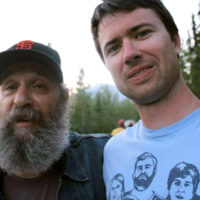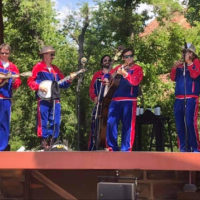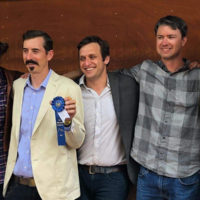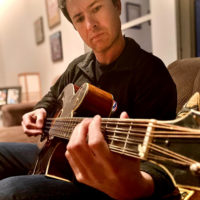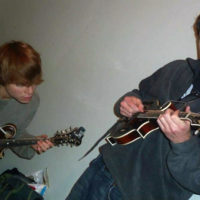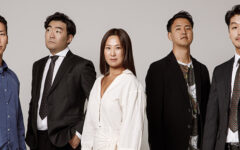
Andrew March is a mainstay in the San Francisco bluegrass scene, playing his clean and melodic mandolin in two bands, the Bow Ties and Trouble Town. Originally from Anchorage, Alaska, as a young musician Andrew gained the guidance of famed Anchorage mandolinist Bernard Glansbeek, and spent most of his youth studying the unique and varied methods of mandolin playing. Andrew is inspired by Mr. Bill Monroe, David Grisman, Sam Bush, Mike Marshall, John Reischman, and Dominick Leslie.
How long have you been playing music and the mandolin?
I started playing guitar when I was about 14 and started playing the mandolin a year later.
There are a lot of California pickers from Alaska. Tell us about the scene up there.
The Alaska scene is great and includes some of my favorite players and people. A lot of folks who travel to Alaska from the lower 48 come away pretty impressed by the quality of both the musicianship and the individuals playing the music. It’s a great hang, to say the least. There’s excellent bluegrass, old-time, Cajun, and Irish music in Alaska, and some killer new acoustic music that dates back to the very early 1980s, when some amazing players up there (some of them now friends of mine) were inspired by David Grisman’s early albums. A lot of Alaskan bluegrass and other acoustic music is on display at the Alaska Folk Festival every April in Juneau, and the Anchorage Folk Festival every January, and there are great bluegrass festivals every summer. Come out!
How was it studying with Bernard Glansbeek?
Bernard is a close friend and has probably been my biggest personal influence in music. I started taking lessons from him when I was 15, a couple of months after buying my first mandolin. We would just sit in his music room and he would show me tunes—usually two or three a week. He’d just returned to Anchorage after spending a few years here in California, where he was pretty dialed into the music scene. He also started giving lessons on mandolin, guitar, and bass to a bunch of my friends as well, such that he had a huge influence on an entire generation of musicians in Alaska. In addition to being an incredible musician—he sounds like himself when he plays—he’s also incredibly kindhearted. By the way, he’d want me to tell anybody who knows him that he said to piss up a rope!
How does the Alaska scene compare to San Francisco?
Well, it’s pretty similar actually—the Bay Area and the overall California scene is also awesome. I would say there are a lot of parallels—high caliber musicians and high-quality people in both scenes. And just like a lot of folks seem to be a bit surprised by the level of musicianship in Alaska, I think a lot of folks are a bit surprised to discover the emphasis on bluegrass tradition in California. Most of the bluegrass in Alaska would fit people’s definition of trad.
What bands were you in in Alaska?
The last band I was in Alaska was with Nate May (guitar), Amanda Kerr (fiddle), and Garren Volper (bass). I really liked that band, but we only did a couple of gigs before I came to California. I also did some gigs as an honorary member of the Booth Family Band, which included Greg Booth, Dan Booth, Mandy Booth, Amanda Kerr, and Andy King—all of whom are incredible players and singers. On a few occasions I flew to Juneau to do gigs with the Great Alaska Bluegrass Band—Junior Kane (banjo), Andrew Heist (mando/fiddle), Scott Burton (guitar), and Brooke Munro (bass)—that band smoked! I did a few gigs with Anna Lynch—an amazing singer and songwriter—and although I wasn’t really in the band, I did have the good fortune to lay a mandocello track on her first record, on a song called Railroad Man. You could also say I was in the house band at the former Tap Root bluegrass night. It was hosted by my good pals Todd Grebe and Nate May. I’ve been playing music with those guys since we were teenagers. And, of course, I have to mention my high school electric band with my oldest friend Chase Christie (bass) and Matt Suddock (guitar). We played a lot of Grateful Dead music and some originals as well.
What bands are you active in now?
I’m currently active in the Bow Ties and Trouble Town. I feel really lucky to have played with the Bow Ties for nearly six years now. I can’t say enough about the talent level in that band, and those guys—Yoseff, Billy, Zach, and Jan—are some of my best friends and favorite musicians. Our banjo player, Billy Moore, recently moved to New Mexico but we’re still going for now—either he flies out for gigs or occasionally we get a sub. We’ve been lucky enough to play with Larry Cohea, Bill Evans, Jack Kinney, and Keith Reed from the great Colorado band, Open Road, among others. The full band was together for RockyGrass last summer as well as our recent New Year’s Eve show with Caleb Klauder and Reeb Willms, which was a blast.
Trouble Town started about a year and a half ago, and playing with them is a lot of fun. The band includes some of my good pals from Alaska, Forrest Allen (mandola) and Eric Rodgers (fiddle). Mark Ignatius plays phenomenal guitar, and the incomparable Pam Brandon plays bass. In addition to bluegrass, the band plays newgrass, gypsy jazz, and Dawg music. We’re at the Kezar Bar & Restaurant in Cole Valley, San Francisco every first and third Wednesday.
What was it like playing at RockyGrass main stage after winning the band competition the previous year?
RockyGrass was awesome. It was a real privilege and super fun to play on that stage, especially with the guys in the Bow Ties. Even though we played at the opening of the festival early on Friday, it was the largest crowd I’ve played in front of. It got my nerves going a little bit, but honestly—for me—not nearly as intense as the band contest the year before. The sound was excellent, and I finally got to see Larry Sparks! Planet Bluegrass is a great organization and made us feel very welcome, even in our tracksuits.
Where did those outfits come from?
We first had the idea to wear more typical tracksuits, and then Yoseff found the red, white, and blue velour suits online. I believe he called to order five of them on a rush basis and the owner of the store took an enthusiastic interest—ultimately embroidering our band logo on the front and adding a rhinestone bow tie, among other things. In fact, I’d like to give a shout out to our sponsor, Sweatsedo. Please consider Sweatsedo for all your tracksuit needs.
Isn’t there a large California presence at RockyGrass?
Yes. We had a ton of friends in attendance when we played, and a lot of them go every year, or close to it.
What are your other favorite festivals?
The Grass Valley Father’s Day festival is obviously fantastic. I’ve also had a great time at the Great 48 and the Good Old Fashioned when I’ve made it. In Alaska, the Granite Creek Picker’s Retreat is always a blast, and I used to love the Anderson Bluegrass Festival, but I’ve heard it’s changed quite a bit.
Do any of your band’s tour and would you want to do that?
I’ve done some mini-tours with the Bow Ties that have been a lot of fun. I would like to do more of it, but it’s tough since everyone in both of the bands has a day job.
Do you play any other instruments?
I play other mandolin family instruments—mandola and mandocello. I spend more time on the mandocello than the mandola. I also play guitar, both acoustic (flatpicking) and electric (both country Tele and Garcia-inspired).
How much do you practice each day?
I try to play as much as possible. Sometimes that will only be a half-hour or forty-five minutes in the morning, and other times (a Saturday with no plans, like yesterday!) I’ll play for eight hours or more.
What’s the hardest part about playing at a high level?
I assume getting there. I’ll let you know when I get there!
What’s your first memory of bluegrass?
I remember listening to the Old & In The Way album for the first time when I was 15, and I was hooked. I read in the liner notes of the CD that Jerry Garcia was playing Pike County Breakdown on banjo when David Grisman first took Peter Rowan to meet him. I wanted to hear that tune, and I found it on a Flatt & Scruggs record. I worked hard to learn Pike County Breakdown from the Flatt & Scruggs album, constantly going back to the beginning of the song and doing my best to at least get Earl’s melody notes on the mandolin. I was pretty disappointed to learn—when I called the tune shortly thereafter while jamming with my mandolin teacher, Bernard Glansbeek, Frank Solivan, and Radim Zenkl—that the tune was actually in A, not Bb. The album I learned it off of had either been sped up or something happened in the process that made it come out in Bb, and I couldn’t play it in A.
You’re a fan of the Dawg. What Grisman tunes are your favorites?
Really hard to pick out favorites, but Janice, Barkley’s Bug, Bow Wow, Opus 12, Caliente, Waiting on Vassar, O’Bannion’s Wake, and Learned Pigs all come to mind. I also love all of Tony Rice’s “spacegrass” albums—songs like Old Gray Coat, Within Specs, Mar West, Moses Sole, Makers Mark, Common Ground, and Backwaters among many—plus all the Miles/Coltrane/standards he recorded: Nardis, On Green Dolphin Street, My Favorite Things—that Reischman break is where it’s at! And of course, Mike Marshall and Darol Anger have written and recorded some of my favorite tunes—Key Signator, Ride the Wild Turkey, Scotch & Swing, Wake Up, Borealis—too many to list!
Why do you think Dawg tunes don’t get called much in bluegrass sessions and how can we fix that?
Good question. Probably a combination of people not knowing the material and choosing to spend their time playing other kinds of music. For all its similarities to bluegrass, it’s a different musical genre, and as much as I love Dawg and other new acoustic music, I’m sure it doesn’t speak to everyone.
What are some tunes you play when you first pick up your instrument?
Recently, when I first pick up my mandolin, I’ve been playing Bill Monroe’s intro to The First Whippoorwill and his first solo from the 1954 recording of White House Blues, because I just learned those breaks. I’ve also been playing Charlie Parker’s Dexterity, which I just learned after seeing Tom Bekeny’s jazz quartet play it.
Do you remember your first instrument?
My first instrument was an Ibanez acoustic guitar. I still have it in Alaska, although the bridge has separated from the body. My first mandolin was an Epiphone A-model—not sure what happened to that mandolin—and I got an ‘80s Kentucky F-style very shortly thereafter, which I played for about ten years. I gave the Kentucky to my mandolin teacher’s brother.
What mandolin do you play now?
I play a 1994 Gilchrist Model 5 that I bought from Tom Rozum. I feel very lucky to own that mandolin and absolutely love it. Best purchase I’ve ever made.
What’s your ultimate musical goal?
Another good question. Keep playing for as long as I can, and hopefully keep improving.
What keeps you busy when you are not playing music?
I ski a lot, both at resorts and the backcountry in either Tahoe or Lassen National Park. I’m a lawyer by day.
Anything else?
I don’t think so! Thanks a lot, Dave!

